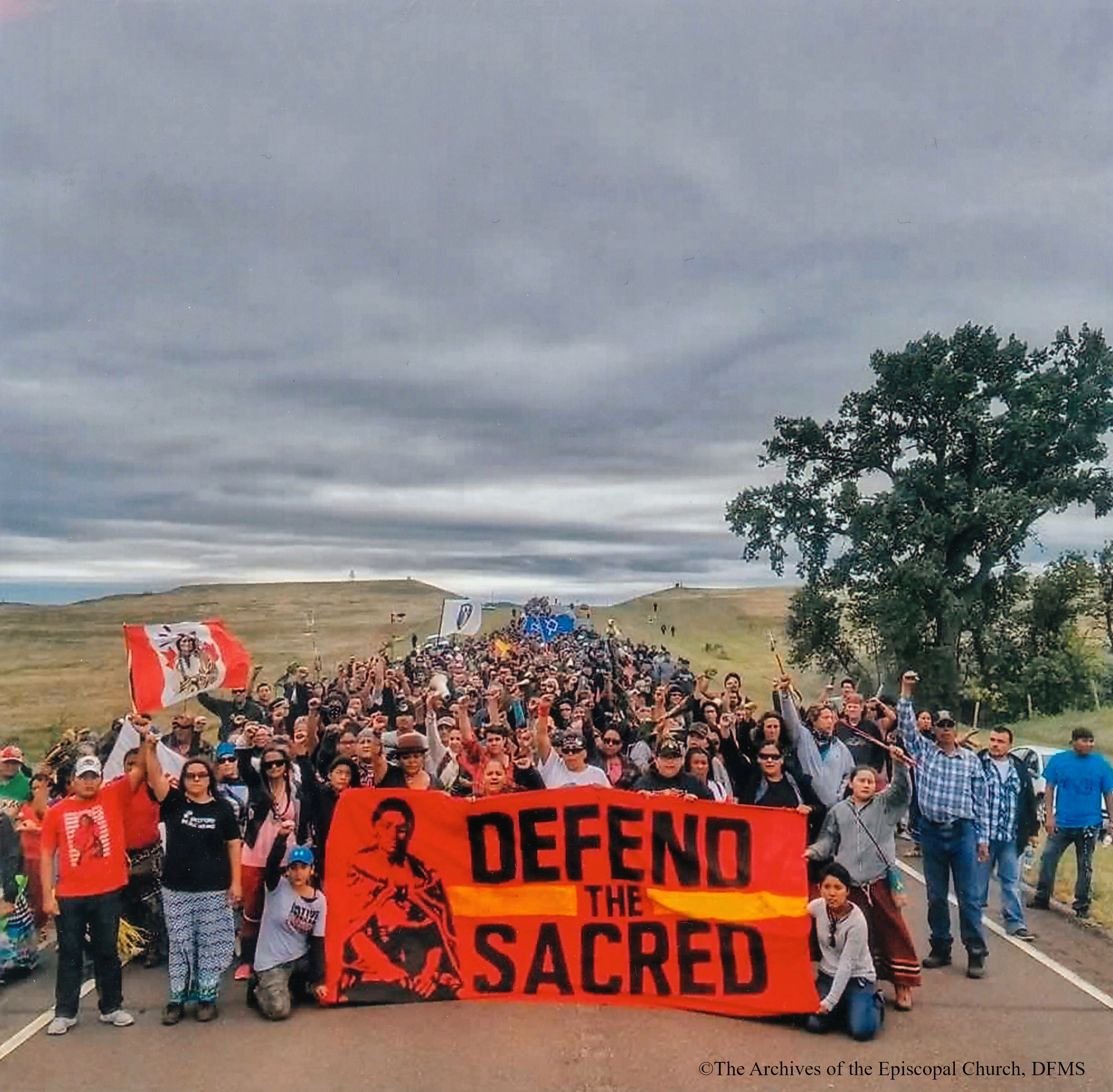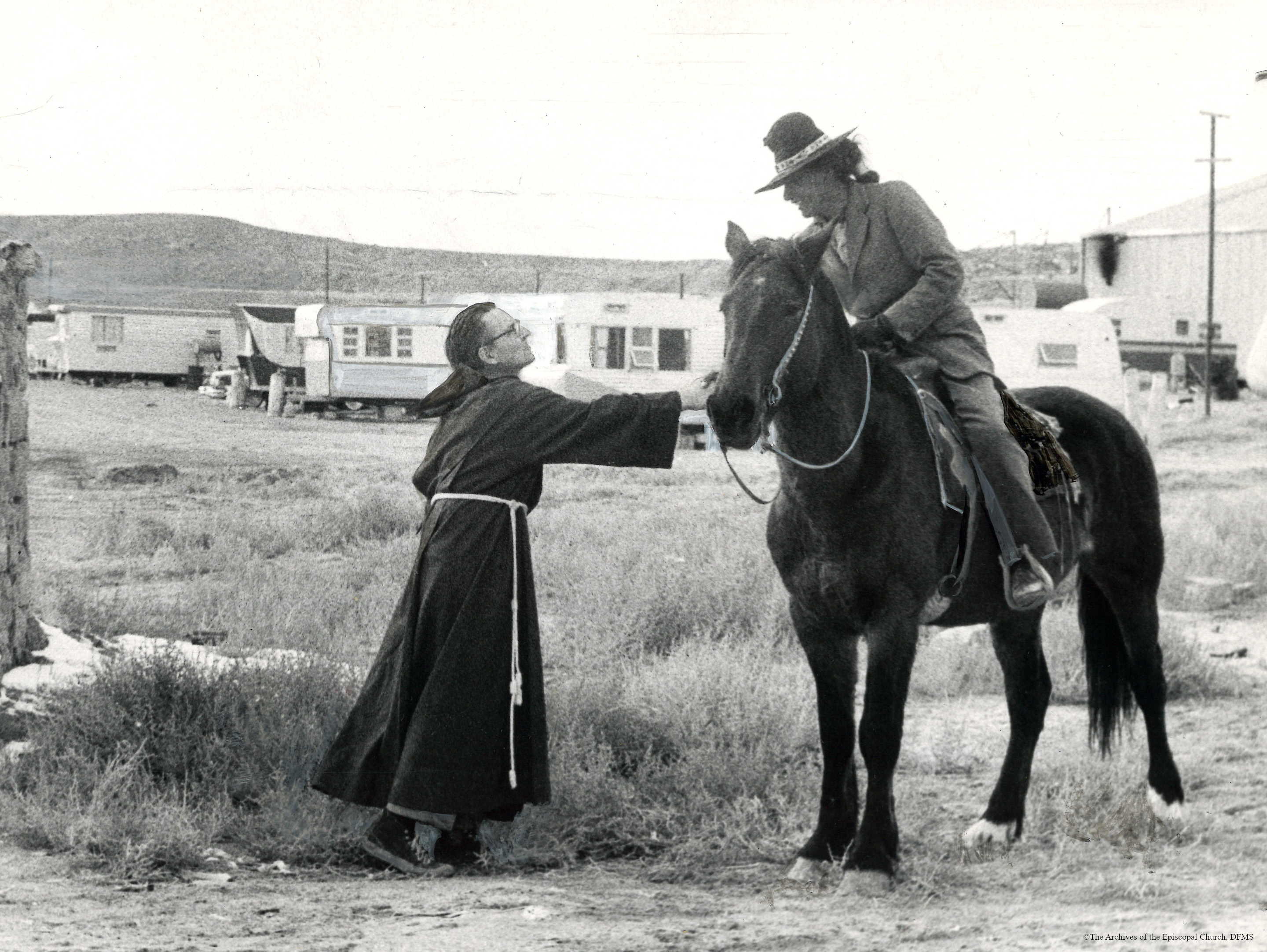Archival Holdings Relating to American Indians and Native Americans
Historical Overview

Dakota Access Pipeline protests, Standing Rock, North Dakota, 2016.
The earliest Episcopal Church missions to the Native Americans of note occurred under the direction of Bishop John Henry Hobart, who began missionary outreach in the early 19th century to the Oneida Indians of New York. The Oneida mission under Eleazar Williams gave birth to similar endeavors in Wisconsin and Minnesota (Chippewas) in the 1850s. Minnesota became the scene of a dedicated attempt to evangelize to the Native American tribes under the leadership of the first bishop, Henry Whipple. Whipple was deeply sympathetic to the cause and condition of American Indians. He served as chair of the government commission on the massacre of Custer’s force at Little Big Horn during the Great Sioux War of 1876, and he advocated successfully for the establishment of the Episcopal Church’s first Indian Commission under the Domestic and Foreign Missionary Society’s Board of Missions. Bishop Whipple is known for having interceded to obtain Lincoln’s clemency in the capital punishment of 269 Native Americans taken as war prisoners after the Dakota Sioux Uprising of 1862. Thirty-eight others were publicly hanged in retribution.
The Church’s involvement in evangelizing Native Americans followed a similar pattern of individual clergy who took significant interest in the plight of relocated tribes within their jurisdictions. Chapels were built near government boarding schools and religious education was introduced. In some cases churches set up their own day and boarding schools (see an Archives Research Report on Episcopal schools for Native Americans). Among notable clerics were the missionary priests Joseph Alexander Gilfillan of Minnesota, who translated the Prayer Book into Ojibwa, Samuel D. Hinman, who translated the Prayer Book into the Dakota language, and Bishop William Hobart Hare who confirmed over seven thousand Native Americans as bishop of Niobrara, a missionary district of what is now western South Dakota. Other important missionary engagements occurred in Alaska under Bishop Peter Trimble Rowe and Archdeacon Hudson Stuck. The missionary district of Navajoland was established in 1976, bringing together several highly local missions of the Southwest at Fort Defiance, Arizona (begun in 1892 as Good Shepherd Mission), New Mexico, and Utah.
The Niobrara Convocation is another important historical engagement that continues today, which brings together friends and relatives annually each summer from different tribes and districts in the Niobrara region, and served as an early example of the blending of ritual Native American and Episcopal traditions. The first Convocation was held on October 5-6, 1870, at Santee, Nebraska. Bishop Robert Harper Clarkson of Nebraska and Dakota issued a call to the clergy of the Dakota field, to hold a meeting for the purpose of organizing an Indian Missionary Convocation.

Group portrait at the first Tanana Chiefs Conference, 1915. Seated front, L to R: Chief Alexander of Tolovana, Chief Thomas of Nenana, Chief Evan of Koschakat, Chief Alexander William of Tanana. Standing at rear, L to R: Chief William of Tanana, Paul Williams of Tanana, and Chief Charlie of Minto.
Once established, The Episcopal Church’s missions tended to be accompanied by either schools or medical clinics. The schools, both day schools and some boarding schools, were sometimes the equivalent of orphanages, but they were also implicated in the removal of children from tribal family structures and their acculturation to western white mores. Bishop Hare adequately captures the paradox of the zealous evangelist who knew best what was good for Indians and succeeded in imposing his institutional vision regardless of the damage it caused along the way. The women of the Church were central to the Church’s work among Native Americans and in their helping role may have had greater impact on the lives of individuals. A considerable amount of funding for schools and aid came from the Women’s Auxiliary and the United Thank Offering. Deaconesses were vital to the teaching and medical care at mission stations and on the reservations. Harriet M. Bedel, who served as a teacher and medical missionary to the Cheyenne in Oklahoma (1910), the Athabascan of the Yukon (1920s), and later to the Southeast Florida Seminoles, was an example of a lifelong commitment to serving Native Americans in what were often arduous assignments.
Other notable figures include many Native Americans who rose through the barriers of white-ruled Church to demonstrate leadership among their own people in capturing and reflecting back a Christian approach to human need. Among these are the acknowledged path breakers such as Enmegahbowh (Minnesota), David Pendleton Oakerhater (Oklahoma), Philip, Vine and Vine Jr. of the Deloria family (South Dakota), Harold S. Jones (South Dakota), Steven Charleston (Alaska), and Steven Plummer (Navajoland). Owanah Anderson was one of several advocates for Native American recognition and redress of racism who worked at the American Indian desk of Episcopal Church Center in New York. She is the acknowledged historian of the Episcopal Church’s engagement with Native Americans in her book, 400 Years: Anglican/Episcopal Mission Among American Indians (Forward Movement: 1997).
Official Records
The earliest records in the custody of The Archives of the Episcopal Church concern the establishment of the Indian Commission (1835–1877). Mission work after that point is documented in the reports and minutes of the Board of Missions and the published reports in the Church newspaper, The Spirit of Missions. The national and diocesan reports of the Women’s Auxiliary are a good source for work occurring in support of local mission congregations and schools. Geographically-focused mission work on Alaska and Hawaii are well represented. Records relating to local mission and ministry would be found in diocesan and parish records, which in the case of South Dakota, Minnesota and Alaska are held by outside repositories. The national effort by The Episcopal Church to address the continuing impact of poverty and racism reemerged in the record around 1956. Pictorial archives were generated primarily by both field missionaries for the purposes of promotional work and to raise funds.
Overseas Department–General Files
Alaska, ca. 1940-1970, 1 cu.ft. of missionary work, area history and correspondence
Hawaii, ca. 1950-1968, .5 cu.ft. of missionary work, area history and correspondence
Board of Missions
Records of the Sub-Committee on Indians/Indian Commission, 1835-1842, 1842-1856, 1870-1871,
1871-1877, 4 oversized minute books
Board of Missions–Alaska
Records, including correspondence files, Commissary Department financial papers, and miscellaneous manuscript and printed material (e.g., interviews, reports, journals, photographs)
1884-1952, 23 cu.ft.
Board of Missions–Hawaii
Records, including letters and reports of clergy and lay missionaries, correspondence of prospective candidates (notably native born applicants), and miscellaneous printed items
1902-1952, 2.5 cu.ft.

Brother Juniper, an Episcopal monk, greets a member of the Navajo Tribe, 1958.
Board of Missions–General Historical Files
Alaska, 1919-1937, 1 file of newsletters and information on individual missions
Hawaii, 1920-1950, 2 files of survey materials and general correspondence
Home Department–Indian Work Records
Records, including pamphlets, leaflets, questionnaires, correspondence, memoranda, studies, reports, position papers, petitions, photographs, and notebooks documenting the Church’s work among Native Americans
1961-1970, 8 cu.ft.
National Committee on Indian Work (NCIW) and Office of the Executive Secretary for Indian Work
Records, including correspondence, minutes, financial records, printed material, reports, photographs, audio tape and other materials, and organized into 4 series: national and regional meetings, grants and grants proposals, organizations associated with the NCIW, and subject files
1968-1977, 4.5 cu.ft.
National Committee on Indian Work
1925, 1956-1969, 1971, .3 cu.ft.
Records of the Department of Research and Field Service
Includes Field Studies of Native American missions
1958-1959, 1.5 cu.ft.
Records of the National Committee on Indian Work
1966-1978, .5 cu.ft.
Records of the Women’s Auxiliary
DFMS Annual and Triennial Reports, 1919-1964
Diocesan Reports, 1873-1956
Domestic and Foreign Missionary Society. Promotions Department, Photographic Records
Includes photographs of Alaskan missions
ca. 1880-1930, 1.5 cu.ft.
Domestic and Foreign Missionary Society. Mission Program, Photographic Records
Includes approximately 356 photographs indexed under Hawaii and approximately 750 images indexed under the subject of American Indians and Native Americans.
Journals of Diocesan Conventions and Councils. Canonical Deposit
Accumulating archive of the published proceedings of annual diocesan conventions, which include the official record of the bishop diocesan’s reports and addresses, clergy and parish lists, annual reports of diocesan agencies, parish statistical reports, diocesan budgets, and directories. Proceedings document the historic relationship and growth of the Church’s Native American membership. Journals of Navajoland are included beginning in 1973.
Diocese of Oklahoma. Diocesan Committee on Indian Affairs
Papers of Lois Clark including correspondence, reports and printed materials regarding David Pendleton Oakerhater
ca. 1984-1990, .3 c.f.
Related Personal Papers
Papers of Peter Trimble Rowe
Comprised mainly of personal correspondence, daily journals, and sermons. Also included are some printed material, newspaper clippings, and photographs. Except for a few items from his early career as a missionary in Canada and Michigan, the majority of the materials pertain to Rowe's career as Bishop of Alaska from 1895-1942.
Papers of Augustus R. Hoare
Comprised of three diaries, two periodicals, two photographs, one letter, and a copy of The Book of Common Prayer. The diaries date from the last years of Hoare's missionary service in Alaska (1912-20), with a gap for the years 1918-19 when he was in California.
1897-1920, .5 cu.ft.
Papers of Mary E. Cochran and David R. Cochran
"A Bridge Over Troubled Water: The Life and Ministry of the First Native American Bishop, Harold S. Jones," by MEC and DRC.
1996, .1 cu.ft., typescript
1875-1943, 5.2 cu.ft.
Audio and Visual Records
Niobrara Oral History Project
Includes video recordings and transcripts of six interviews conducted in 2012 by The Archives of the Episcopal Church with members of the parishes and dioceses that comprise what is known as the Niobrara Convocation, covering North Dakota, South Dakota, Minnesota. Interviews were conducted onsite at the 140th Niobrara Convocation held at Standing Rock Middle School, Ft. Yates, North Dakota, June 15, 2012.
Oral Interviews with the Right Reverend Harold S. Jones
The collection includes audio interviews conducted with Bishop Harold S. Jones by Mary Cochran, circa 1978-1980. Original interviews were recorded on audio cassette tape, and a few (but not all) include accompanied transcriptions. In 2013, the tapes were digitized for preservation and access.
Printed Material
Domestic and Foreign Missionary Society. The Spirit of Missions
1836-1938. National news journal on missionary activity of the Board of Missions.
Book of Common Prayer: Selections from the Custodian’s Collection, the Andrews Prayer Book Collection, and the Archives Prayer Book and Liturgy Collection:
1871, Dakota and English, for Jurisdiction of Niobrara
1853, Ojibwa language version
1877 and 1890, Cree language version
1912, Takudh language version
1979, “Canadian Indian Language” version
1915, Culic (Alaskan Indian) language version
1875, 1909, 1918, 1937, 1962, Dakota language version
1908, Tanana (Alaskan Indian) language version
1923, Tigara (Alaskan Indian) language version
1883, Hawaiian language version
1889, Okodakiciye Wakan Tadowan Kin (Dakota Hymnal)
Episcopal Church Documents-in-Print Collection
Contain 51 titles on the topic of Indians, Native Americans, and Alaska
1844-2000
Publications of the Office of Native American Ministries
ca. 1955-1968, .3 cu.ft.
Guide to the Archives of the Episcopal Church in South Dakota
An Overview of the Diocese of South Dakota’s archival holdings, 1981.
